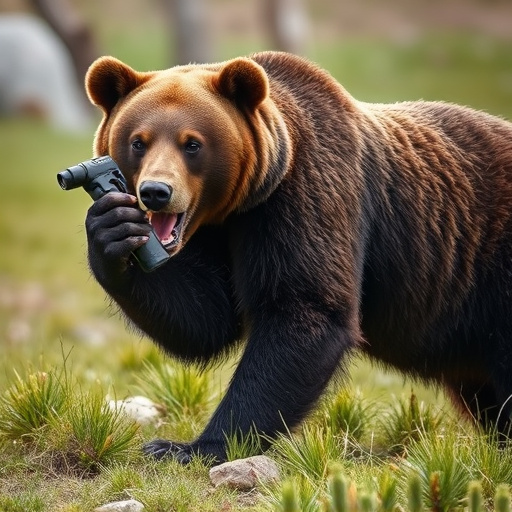Bear spray is a powerful deterrent against aggressive bears, using capsaicin to temporarily incapacitate them during close encounters. Its effectiveness and legality vary globally; while allowed in some national parks and wilderness areas, it's prohibited in others due to conservation and safety concerns, especially in urban settings. Always check local regulations regarding bear spray use, focusing on legal permissions for maximum safety during potential bear interactions. Proper storage, handling, and usage techniques – maintaining eye contact, aiming for the face and eyes, and backing away – ensure its effectiveness while adhering to restrictions on where bear spray is permitted.
“Uncover the power of bear spray—a potent defense mechanism in the great outdoors. This comprehensive guide explores the science behind its effectiveness, offering insights on when and where to deploy it optimally. From understanding its active ingredients to navigating legal restrictions, we delve into best practices for storage and safe usage.
Learn about the regions where Bear Spray use is prohibited, ensuring you’re prepared and compliant during your adventures. Maximize your safety and know when this powerful tool is your best defense.”
- Understanding Bear Spray: What It Is and How It Works
- When and Where to Use Bear Spray for Maximum Effectiveness
- Legal Considerations: Where Is Bear Spray Prohibited?
- Best Practices for Storing and Using Bear Spray Safely
Understanding Bear Spray: What It Is and How It Works
Bear spray, also known as bear deterrent spray, is a specialized pepper spray designed to protect individuals from aggressive bears. It’s a powerful defense mechanism that can temporarily incapacitate an attacking bear, allowing time for escape or assistance to arrive. The spray creates a barrier between the user and the bear by using a combination of capsaicin, the active ingredient found in chili peppers, and other agents to cause irritation and pain. This irritates the bear’s eyes, nose, and respiratory system, leading to temporary disorientation and reduced aggression.
Understanding how bear spray works is crucial when considering its maximum stopping power. However, it’s important to note that there are specific situations where bear spray might be prohibited or restricted. National parks and certain wilderness areas often have regulations regarding the carrying of bear spray due to concerns about wildlife conservation and human safety. Always check local laws and guidelines before venturing into bear country to ensure compliance with regulations and maximize your safety.
When and Where to Use Bear Spray for Maximum Effectiveness
When using bear spray, timing and location are crucial for maximum effectiveness. It’s most effective during close encounters with bears, when the animal is displaying aggressive or defensive behavior, such as charging, growling, or swatting at you. Spraying early can deter a bear from approaching, while applying it accurately at close range can stop an attack in its tracks.
It’s important to remember that bear spray isn’t universally permitted everywhere. In some areas, including national parks and certain wilderness regions, carrying and using bear spray might be prohibited due to concerns over its impact on wildlife or the environment. Always check local regulations regarding bear spray use before venturing into bear country.
Legal Considerations: Where Is Bear Spray Prohibited?
Bear spray, while an effective defense against bears, is subject to various legal restrictions and prohibitions depending on the region. It’s crucial for users to understand where its use is not only permissible but also encouraged by local laws and regulations. In many national parks and wilderness areas, bear spray is mandatory equipment for visitors, especially during peak season when bear activity is most prevalent. However, certain locations have strict rules against carrying or using bear spray.
Some urban areas and densely populated regions may prohibit the possession of bear spray due to safety concerns or local ordinances. It’s also important to note that international travel with bear spray can be challenging, as different countries have varying regulations regarding the import and use of pepper spray or similar products. Before heading outdoors or traveling abroad, individuals should check local and national laws to ensure compliance and avoid legal repercussions related to bear spray possession or use.
Best Practices for Storing and Using Bear Spray Safely
When storing bear spray, it’s crucial to keep it in an accessible yet secure location. Always store it out of reach of children and pets, in a cool, dry place, and never leave it unattended. Bear spray is highly effective when used correctly, but improper storage or handling can render it ineffective or even dangerous. Ensure the canister remains sealed until needed, as exposure to heat or direct sunlight can reduce its potency.
Using bear spray safely involves understanding its range and effectiveness. Never aim it at a bear unless absolutely necessary; instead, use it as a last resort when a bear exhibits aggressive behavior. Maintain eye contact with the bear, and spray from an angle, aiming for the face and eyes. Back away slowly after spraying, giving the bear ample space to retreat. Remember, where bear spray is prohibited—such as in urban areas or national parks—carrying it might not be permitted, so always check local regulations regarding its use and storage.
Bear spray is a powerful tool for personal defense against bears, but understanding its usage, storage, and legal boundaries is essential. By knowing where and when to deploy it effectively, and being aware of prohibited areas as outlined in this article, individuals can enhance their safety when encountering bears. Always follow best practices for safe handling and storage, ensuring you’re prepared for potential encounters while respecting regulations regarding bear spray use. Remember, prevention and knowledge are key to navigating wild environments safely.
